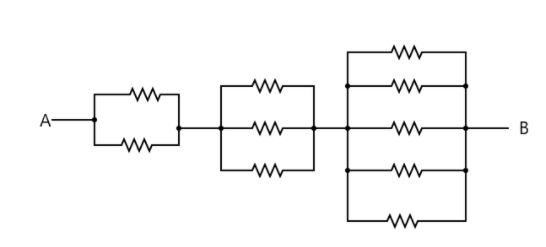
A number of 24 ohms resistors are connected as shown in figure. Then the effective resistance between P and Q is

(A) \[21.6\Omega \]
(B) \[24.8\Omega \]
(C) \[26\Omega \]
(D) \[36\Omega \]
Answer
218.7k+ views
Hint: The two resistors on the left are parallel to each other, and similarly, the three resistors in the middle and the five resistors at the end are also separately parallel to each other. These equivalent resistances of each of the parallel resistance networks are in series to each other.
Formula used: In this solution we will be using the following formulae;
\[{R_{eqs}} = {R_1} + {R_2} + ... + {R_n}\] where \[{R_{eqs}}\] is the equivalent resistance of resistors connected in series, and \[{R_1}...{R_n}\] are the individual resistors in series.
\[\dfrac{1}{{{R_{eqp}}}} = \dfrac{1}{{{R_1}}} + \dfrac{1}{{{R_2}}} + ... + \dfrac{1}{{{R_n}}}\] where \[{R_{eqp}}\] is the equivalent resistance of resistors in a parallel arrangement, and \[{R_1}...{R_n}\] are the individual resistors in parallel.
Complete Step-by-Step solution:
From the diagram, we see that the two leftmost resistors are in series to one another, hence, we combine these resistors using the parallel combination formula. The equivalent resistance of resistances in parallel is given by
\[\dfrac{1}{{{R_{eqp}}}} = \dfrac{1}{{{R_1}}} + \dfrac{1}{{{R_2}}} + ... + \dfrac{1}{{{R_n}}}\] where \[{R_1}...{R_n}\] are the individual resistors in parallel.
For the two resistances, we have
\[\dfrac{1}{{{R_{eqp}}}} = \dfrac{1}{{24}} + \dfrac{1}{{24}} = \dfrac{2}{{24}}\] (recall from question that all the resistances are 24 ohms)
\[ \Rightarrow {R_{eqs1}} = 12\Omega \]
Similarly, the three resistance of in the middle, are also in series, hence,
\[\dfrac{1}{{{R_{eqp2}}}} = \dfrac{1}{{24}} + \dfrac{1}{{24}} + \dfrac{1}{{24}} = \dfrac{3}{{24}}\]
\[ \Rightarrow {R_{eqs2}} = 8\Omega \]
Similarly for the rightmost arrangement of 5 parallel resistances, we have \[\dfrac{1}{{{R_{eqp2}}}} = \dfrac{1}{{24}} + \dfrac{1}{{24}} + \dfrac{1}{{24}} + \dfrac{1}{{24}} + \dfrac{1}{{24}} = \dfrac{5}{{24}}\]
\[ \Rightarrow {R_{eqs3}} = \dfrac{{24}}{5} = 4.8\Omega \]
Now, each of the equivalent parallel resistances are actually in series with each other. The equivalent resistance of resistances in series can be given as
\[{R_{eqs}} = {R_1} + {R_2} + ... + {R_n}\] where \[{R_{eqs}}\] is the equivalent resistance of resistors connected in series, and \[{R_1}...{R_n}\] are the individual resistors in series.
Hence, we have
\[{R_{eqs}} = 12 + 8 + 4.8 = 24.8\Omega \]
Hence, the correct option is B
Note: For understanding, resistors are said to be in series if current moving through one of them is equal to the current flowing through the others. Resistors are in parallel if the voltage across each of them are equal to the other.
Formula used: In this solution we will be using the following formulae;
\[{R_{eqs}} = {R_1} + {R_2} + ... + {R_n}\] where \[{R_{eqs}}\] is the equivalent resistance of resistors connected in series, and \[{R_1}...{R_n}\] are the individual resistors in series.
\[\dfrac{1}{{{R_{eqp}}}} = \dfrac{1}{{{R_1}}} + \dfrac{1}{{{R_2}}} + ... + \dfrac{1}{{{R_n}}}\] where \[{R_{eqp}}\] is the equivalent resistance of resistors in a parallel arrangement, and \[{R_1}...{R_n}\] are the individual resistors in parallel.
Complete Step-by-Step solution:
From the diagram, we see that the two leftmost resistors are in series to one another, hence, we combine these resistors using the parallel combination formula. The equivalent resistance of resistances in parallel is given by
\[\dfrac{1}{{{R_{eqp}}}} = \dfrac{1}{{{R_1}}} + \dfrac{1}{{{R_2}}} + ... + \dfrac{1}{{{R_n}}}\] where \[{R_1}...{R_n}\] are the individual resistors in parallel.
For the two resistances, we have
\[\dfrac{1}{{{R_{eqp}}}} = \dfrac{1}{{24}} + \dfrac{1}{{24}} = \dfrac{2}{{24}}\] (recall from question that all the resistances are 24 ohms)
\[ \Rightarrow {R_{eqs1}} = 12\Omega \]
Similarly, the three resistance of in the middle, are also in series, hence,
\[\dfrac{1}{{{R_{eqp2}}}} = \dfrac{1}{{24}} + \dfrac{1}{{24}} + \dfrac{1}{{24}} = \dfrac{3}{{24}}\]
\[ \Rightarrow {R_{eqs2}} = 8\Omega \]
Similarly for the rightmost arrangement of 5 parallel resistances, we have \[\dfrac{1}{{{R_{eqp2}}}} = \dfrac{1}{{24}} + \dfrac{1}{{24}} + \dfrac{1}{{24}} + \dfrac{1}{{24}} + \dfrac{1}{{24}} = \dfrac{5}{{24}}\]
\[ \Rightarrow {R_{eqs3}} = \dfrac{{24}}{5} = 4.8\Omega \]
Now, each of the equivalent parallel resistances are actually in series with each other. The equivalent resistance of resistances in series can be given as
\[{R_{eqs}} = {R_1} + {R_2} + ... + {R_n}\] where \[{R_{eqs}}\] is the equivalent resistance of resistors connected in series, and \[{R_1}...{R_n}\] are the individual resistors in series.
Hence, we have
\[{R_{eqs}} = 12 + 8 + 4.8 = 24.8\Omega \]
Hence, the correct option is B
Note: For understanding, resistors are said to be in series if current moving through one of them is equal to the current flowing through the others. Resistors are in parallel if the voltage across each of them are equal to the other.
Recently Updated Pages
A square frame of side 10 cm and a long straight wire class 12 physics JEE_Main

The work done in slowly moving an electron of charge class 12 physics JEE_Main

Two identical charged spheres suspended from a common class 12 physics JEE_Main

According to Bohrs theory the timeaveraged magnetic class 12 physics JEE_Main

ill in the blanks Pure tungsten has A Low resistivity class 12 physics JEE_Main

The value of the resistor RS needed in the DC voltage class 12 physics JEE_Main

Trending doubts
JEE Main 2026: Application Form Open, Exam Dates, Syllabus, Eligibility & Question Papers

Derivation of Equation of Trajectory Explained for Students

Hybridisation in Chemistry – Concept, Types & Applications

Understanding the Angle of Deviation in a Prism

Understanding Collisions: Types and Examples for Students

Understanding Atomic Structure for Beginners

Other Pages
JEE Advanced Marks vs Ranks 2025: Understanding Category-wise Qualifying Marks and Previous Year Cut-offs

How to Convert a Galvanometer into an Ammeter or Voltmeter

Understanding Centrifugal Force in Physics

JEE Main Marking Scheme 2026- Paper-Wise Marks Distribution and Negative Marking Details

Degree of Dissociation: Meaning, Formula, Calculation & Uses

Understanding Electromagnetic Waves and Their Importance




